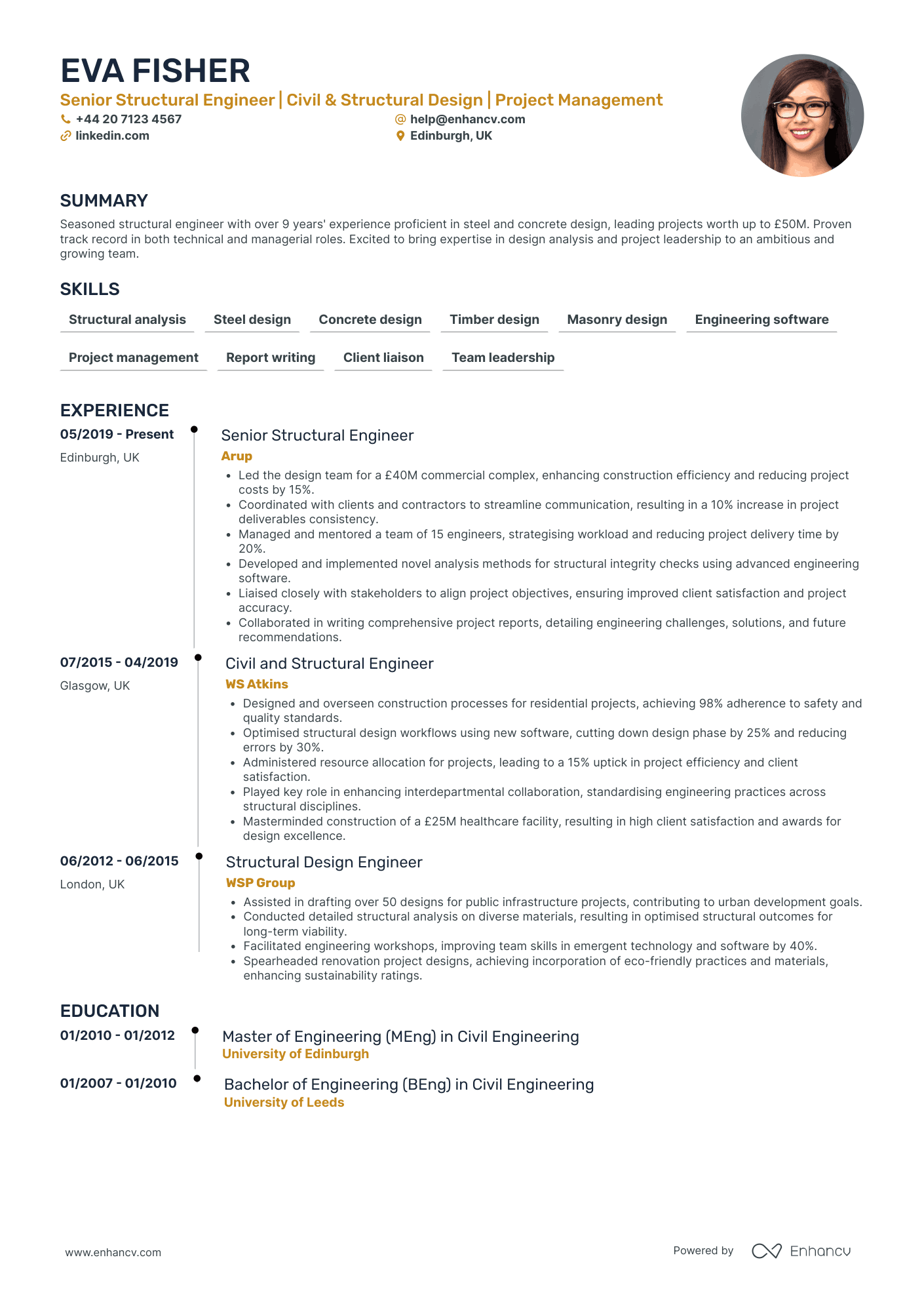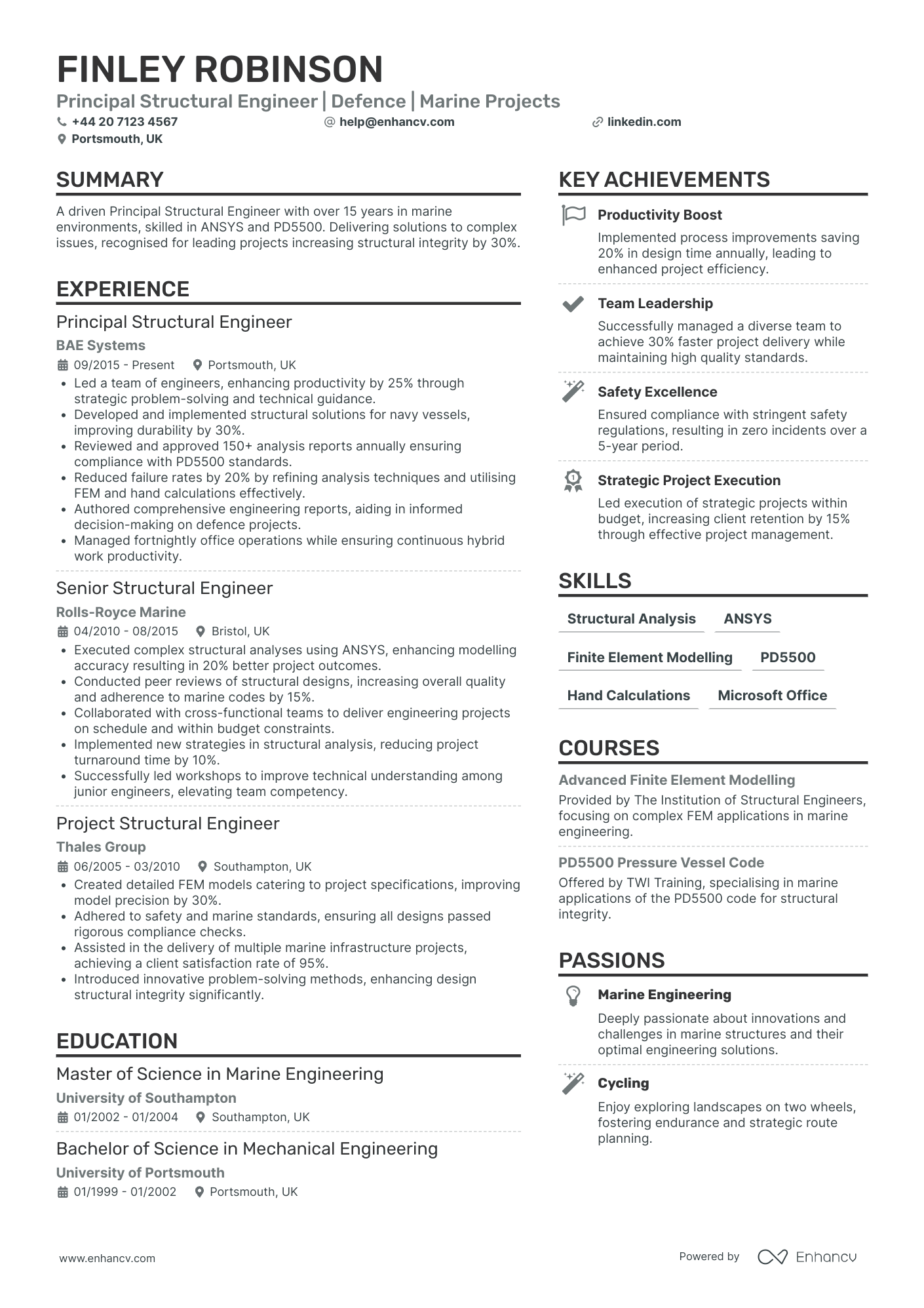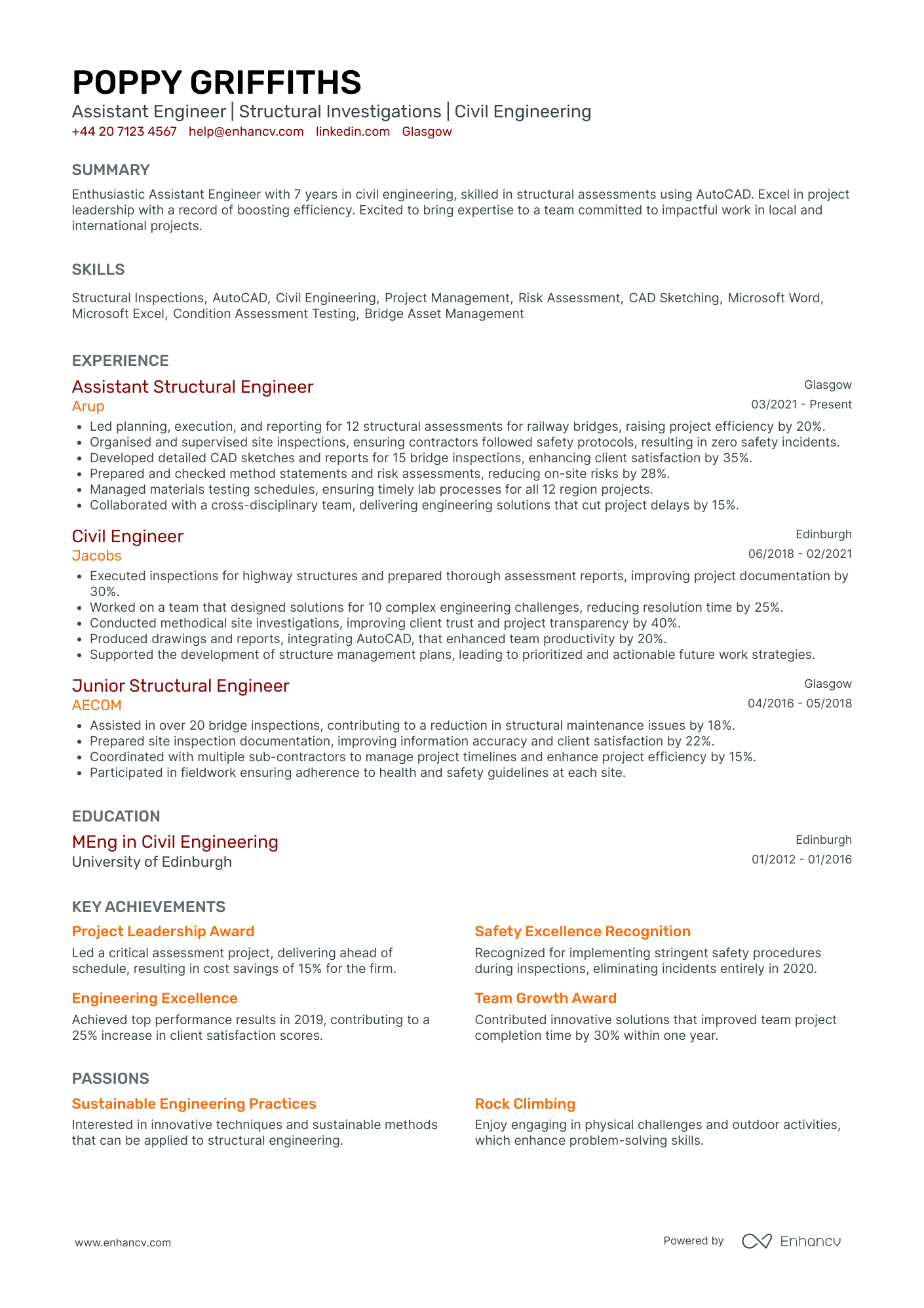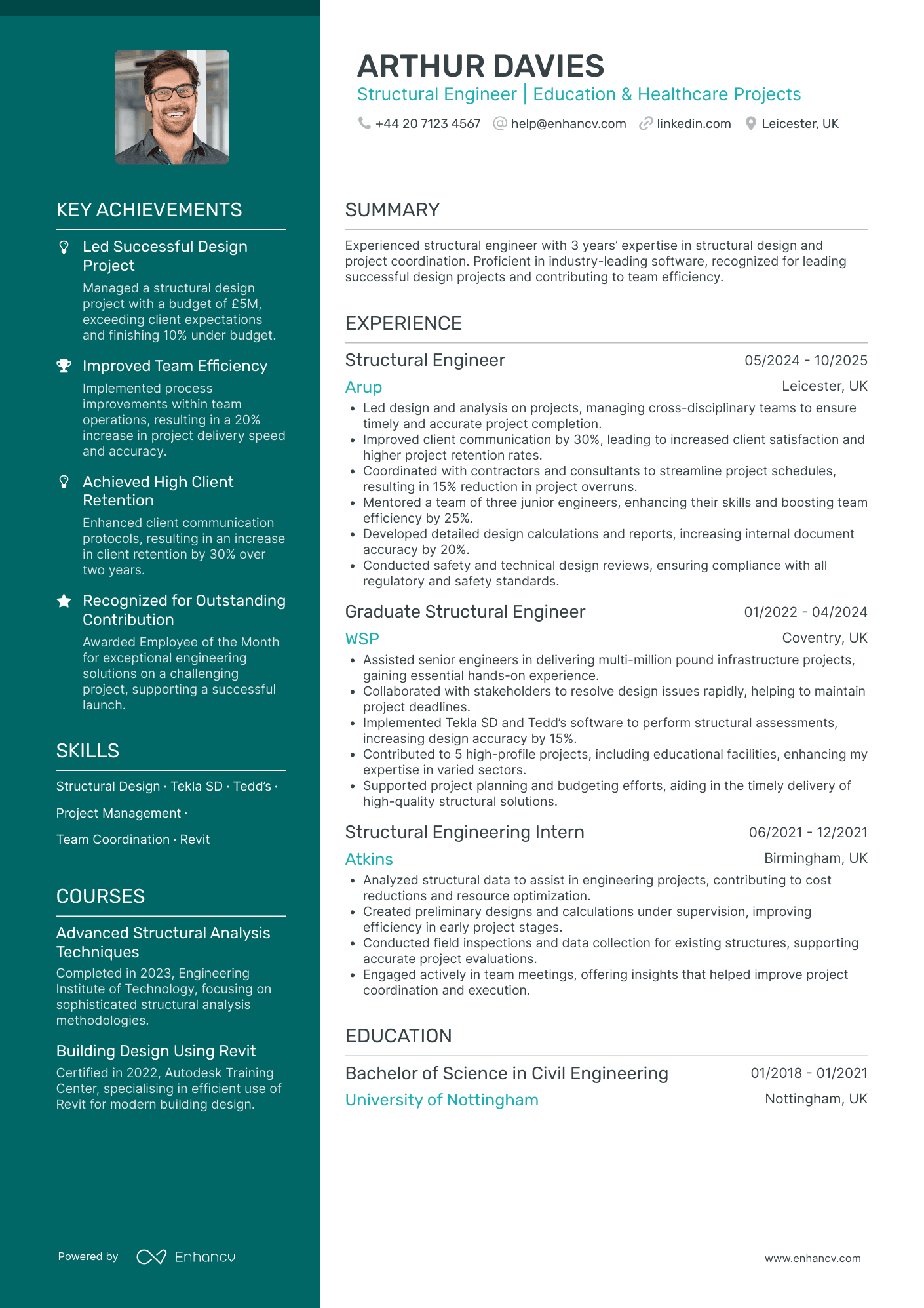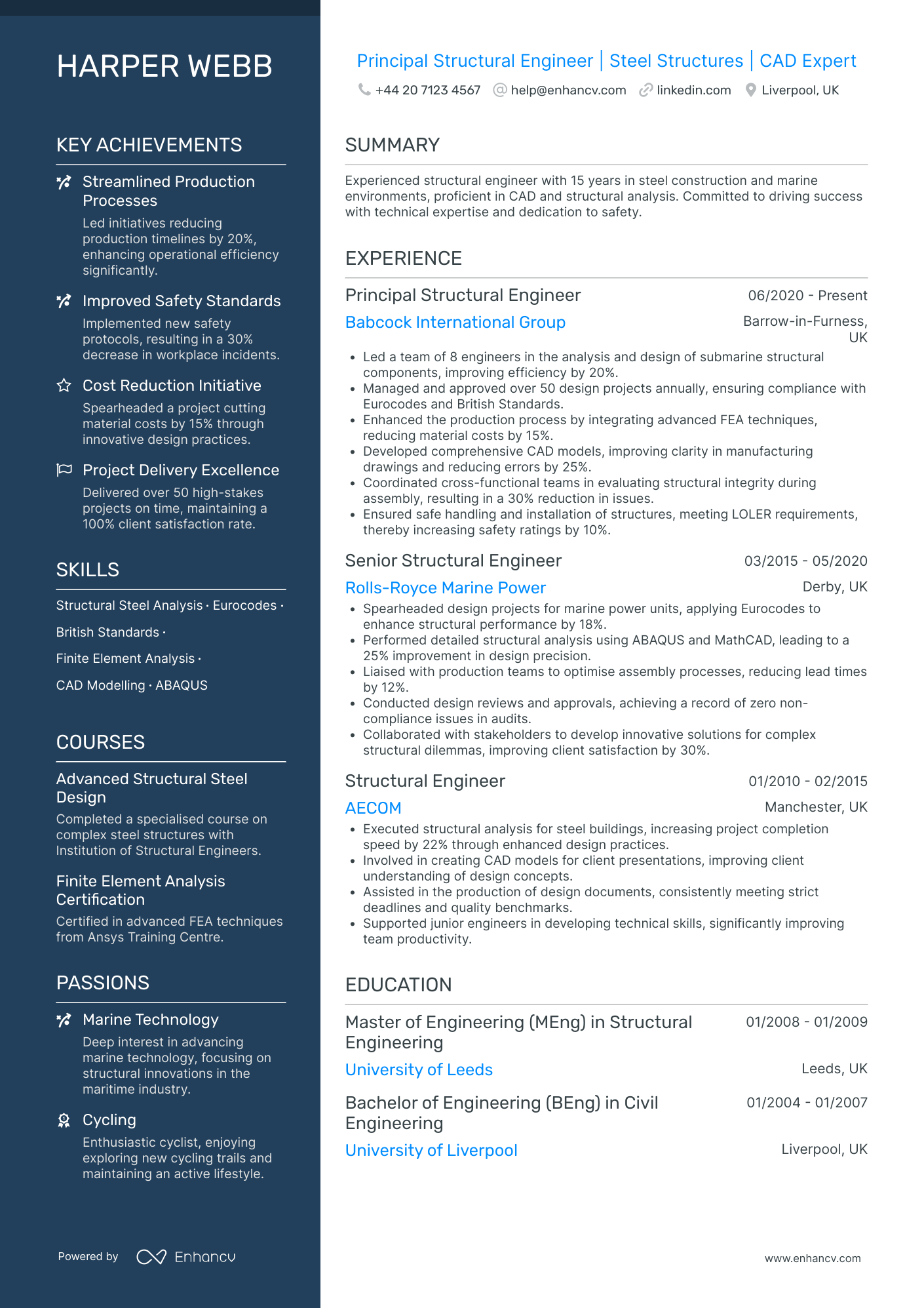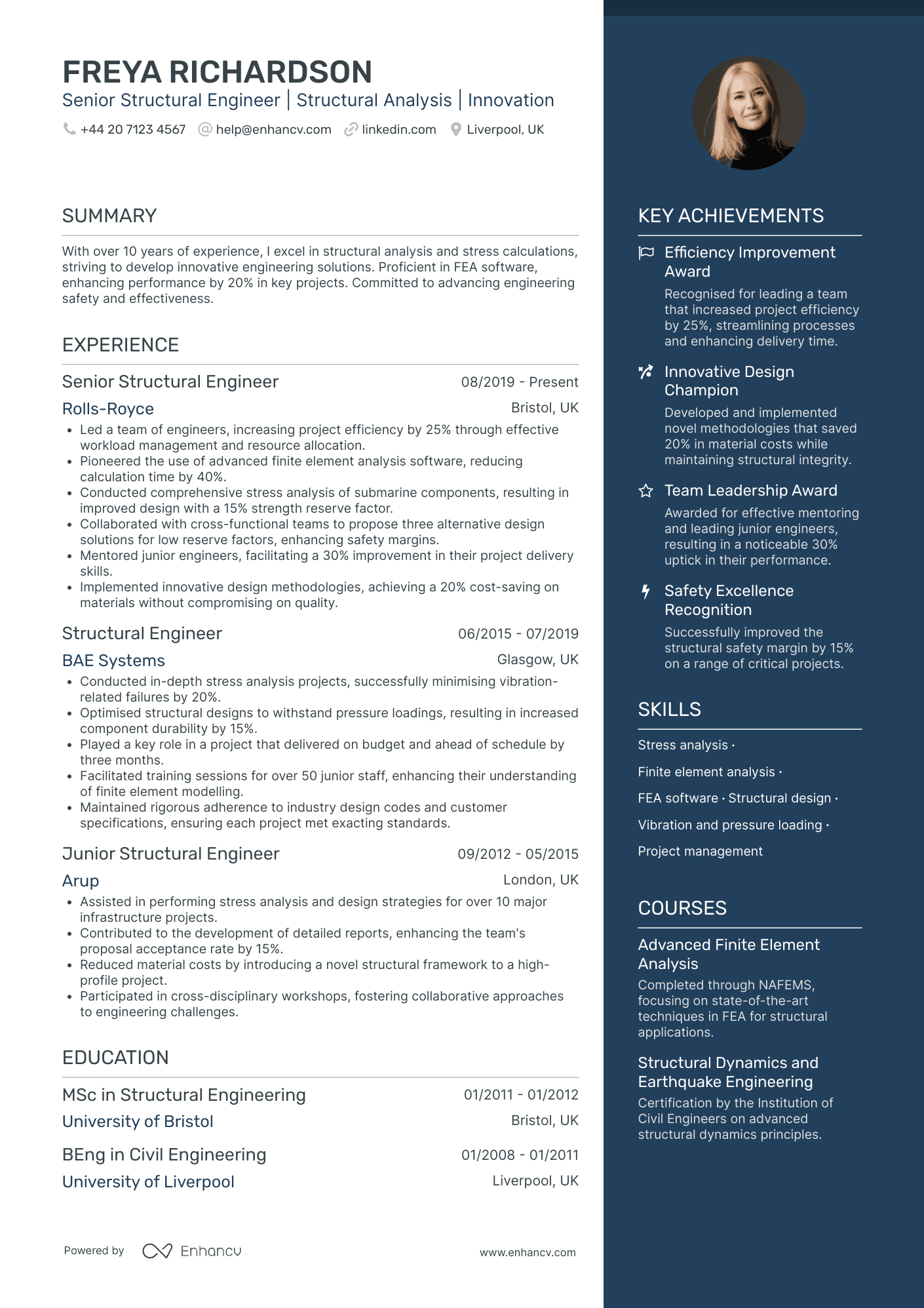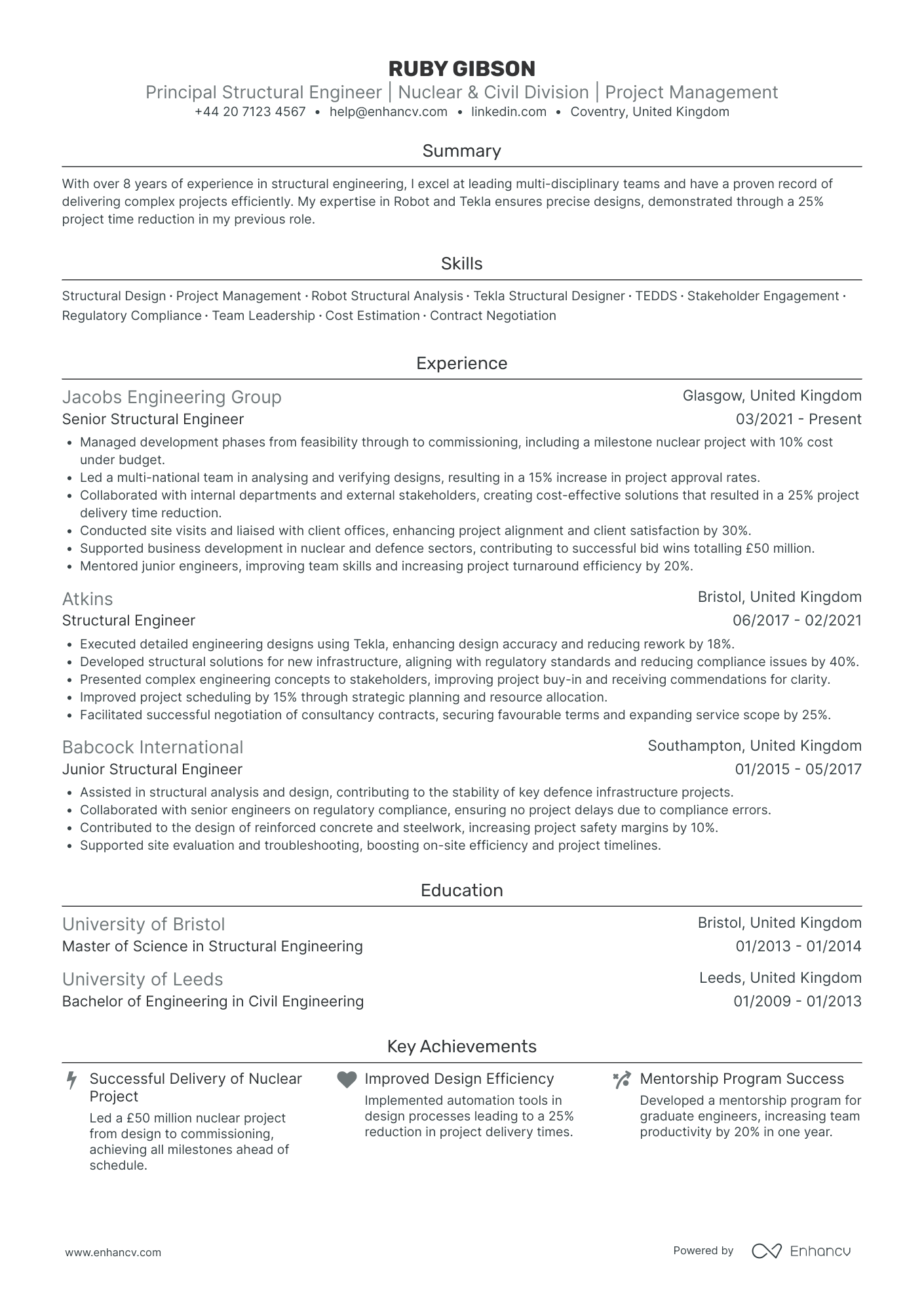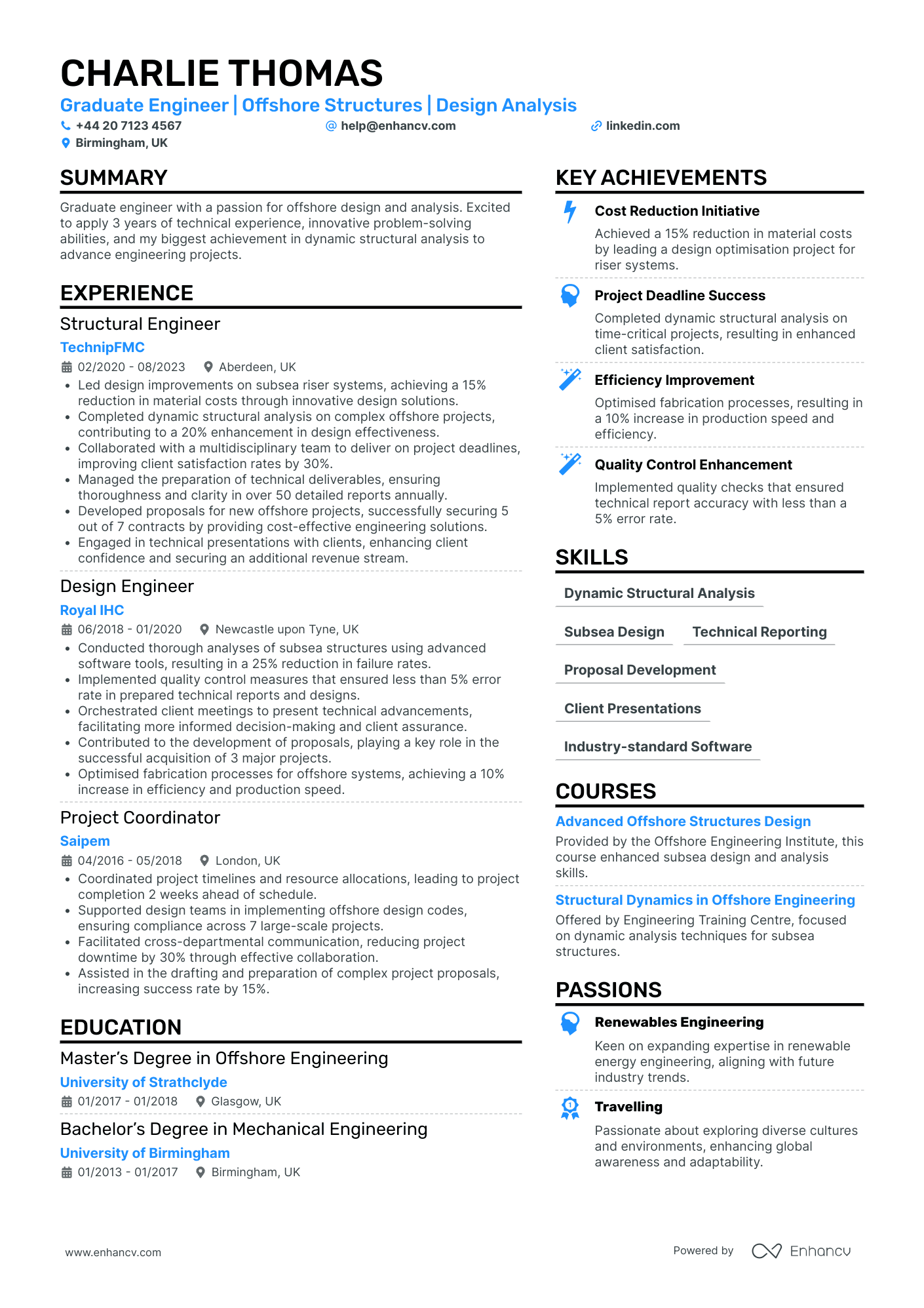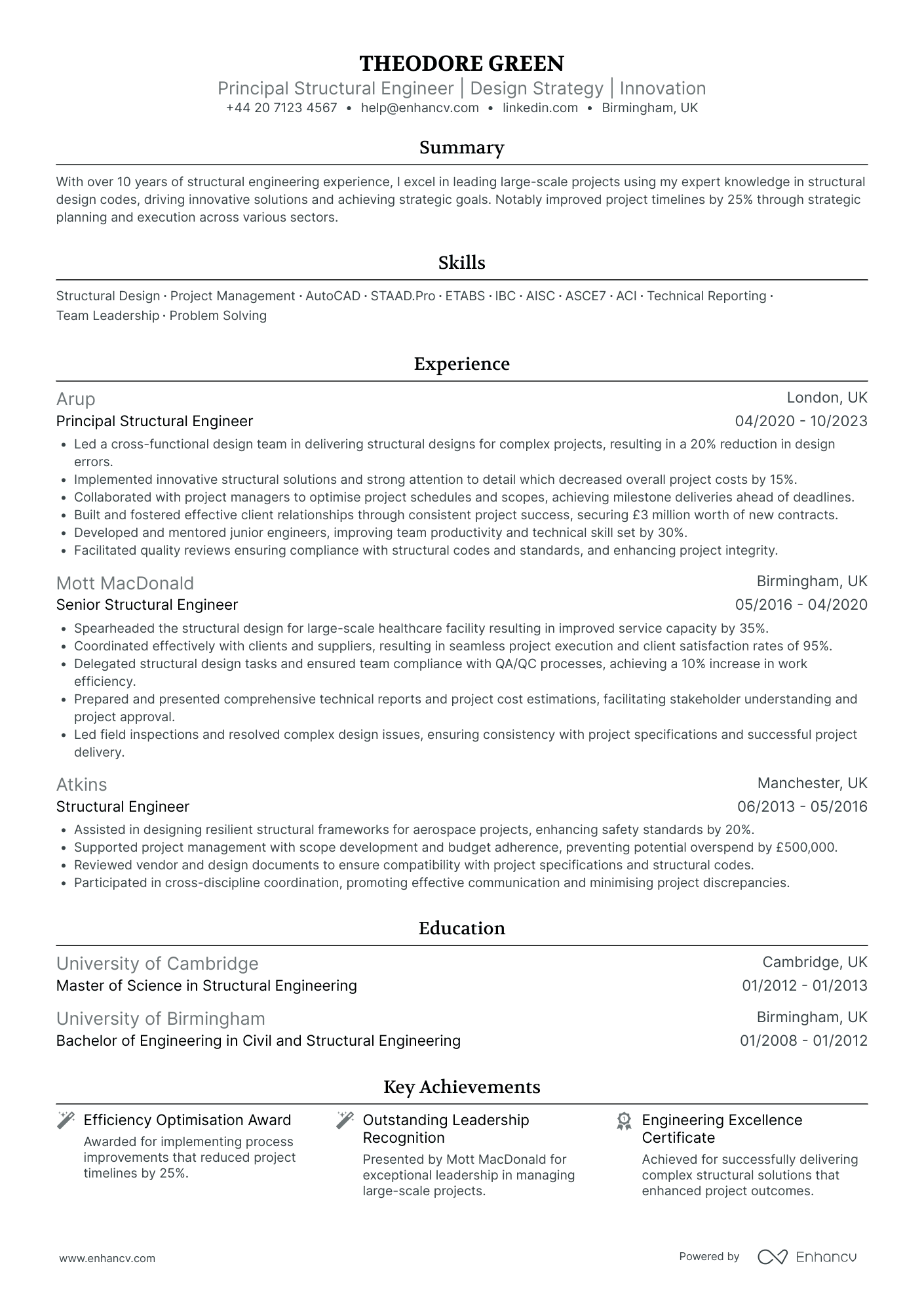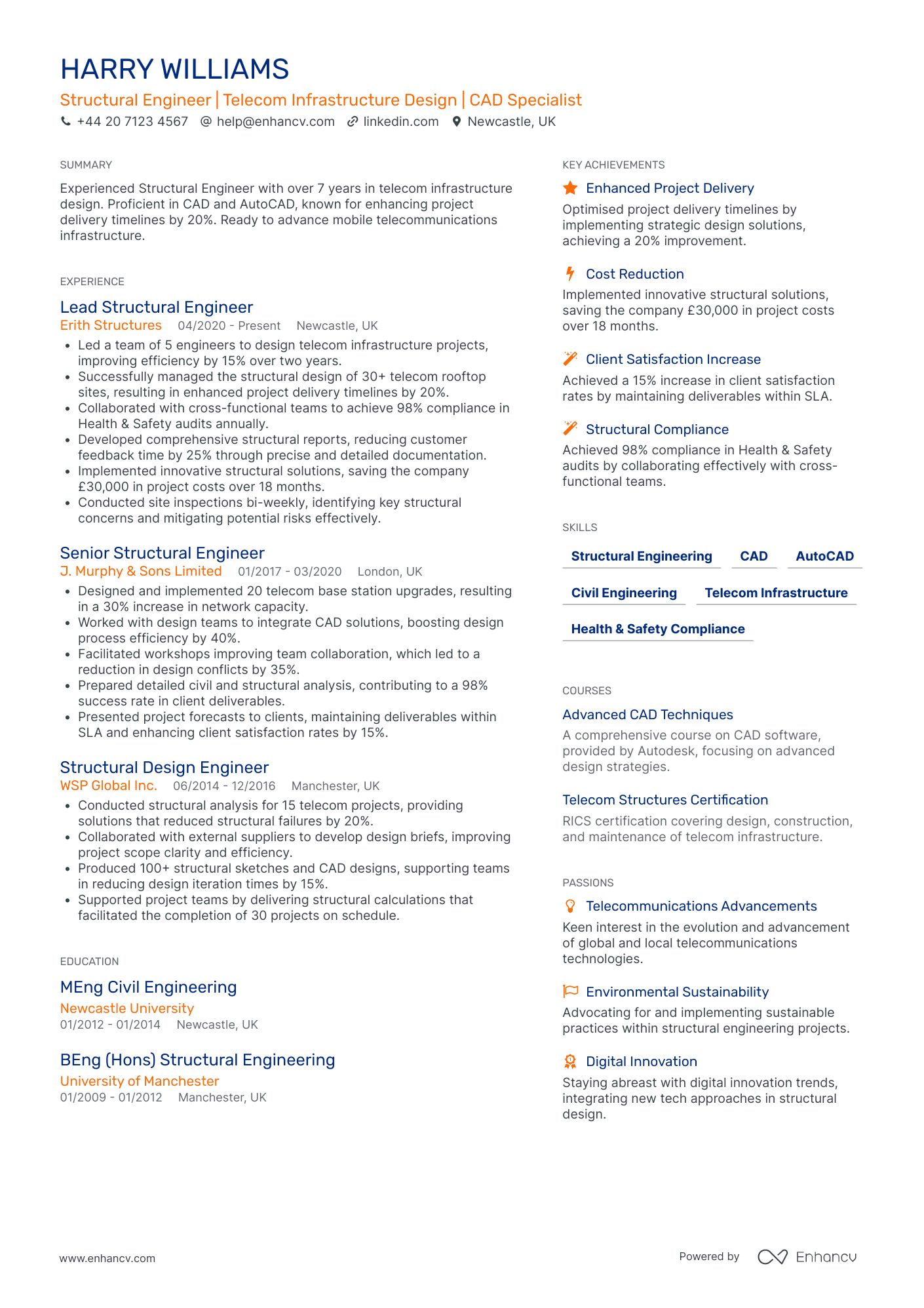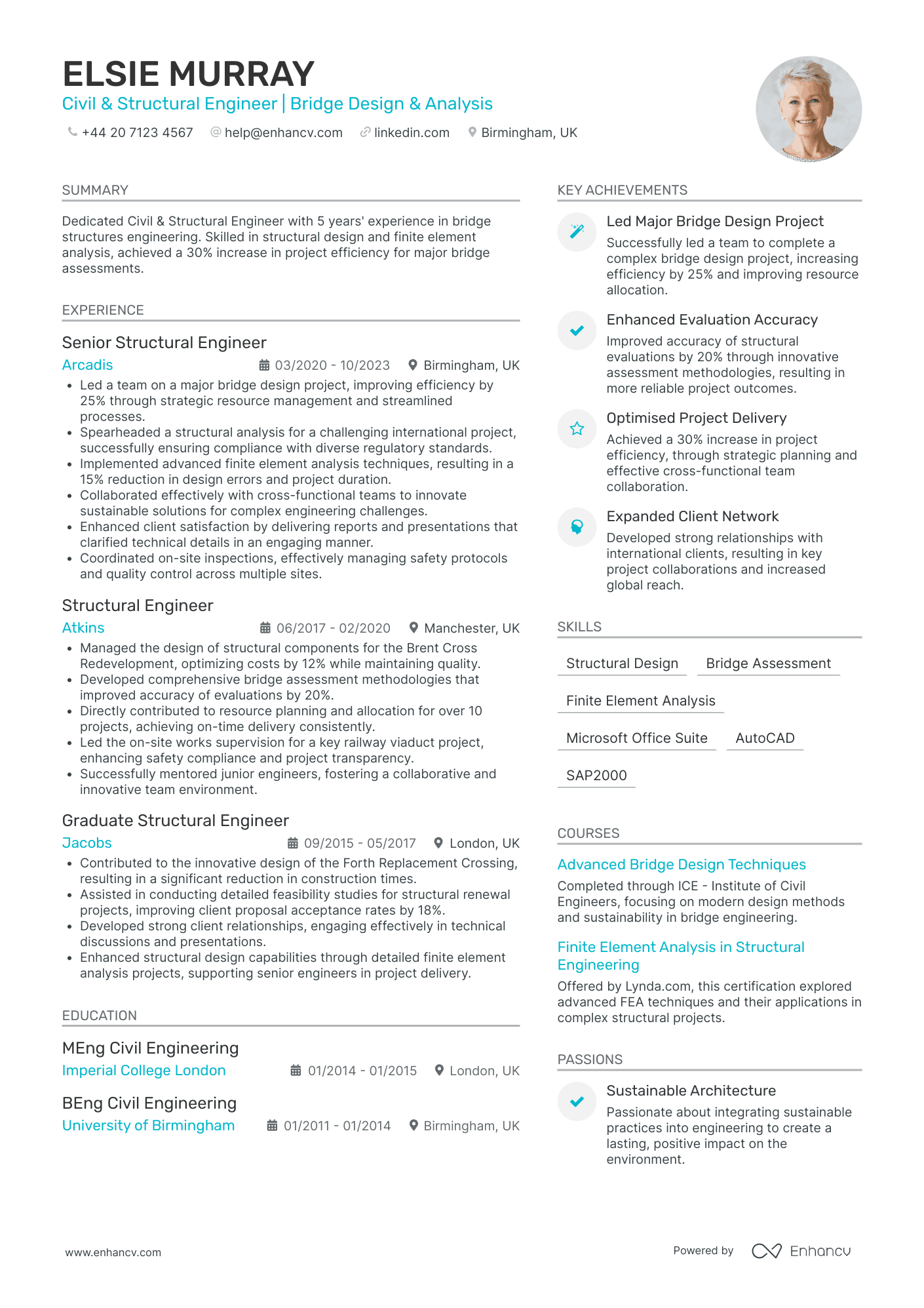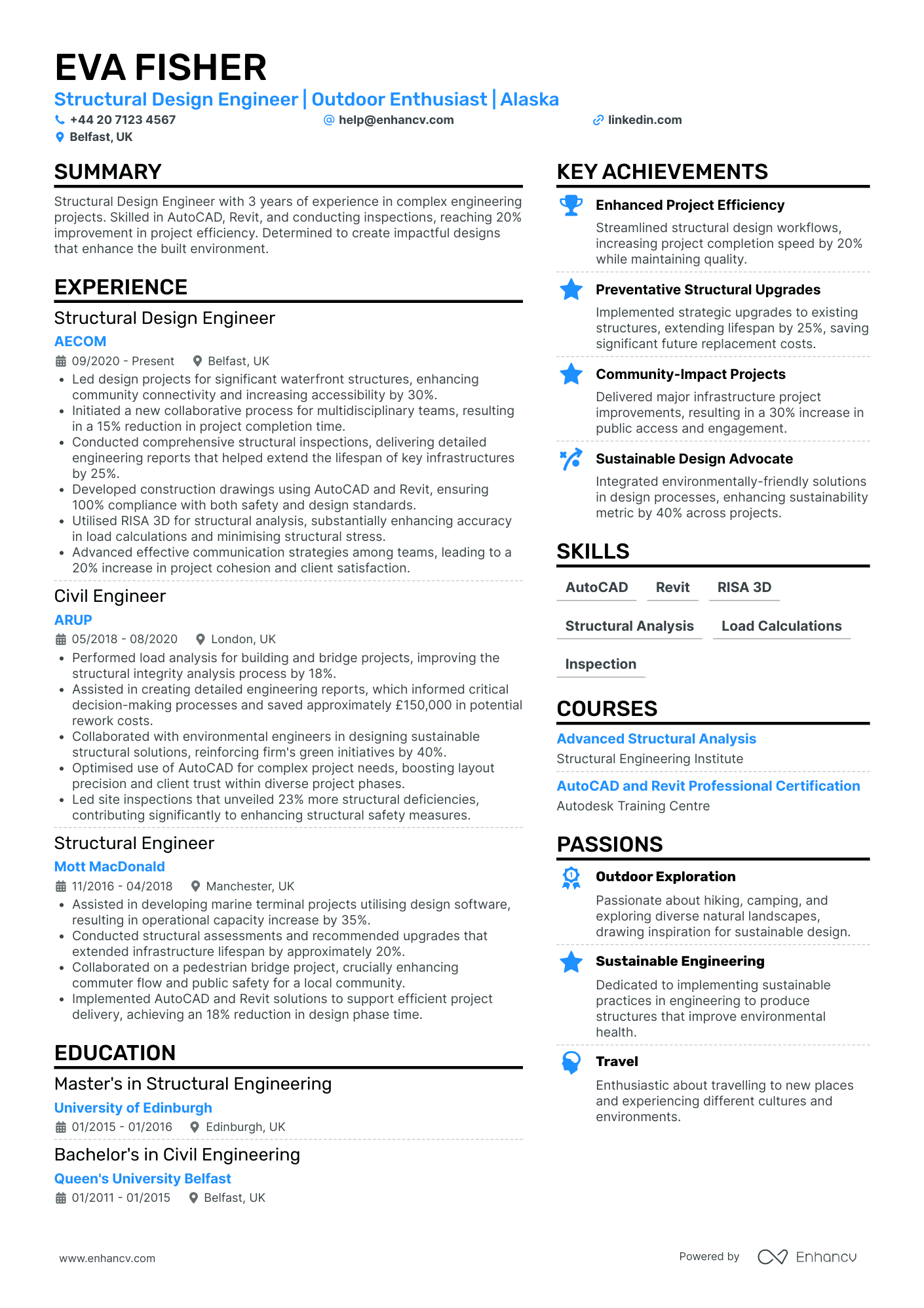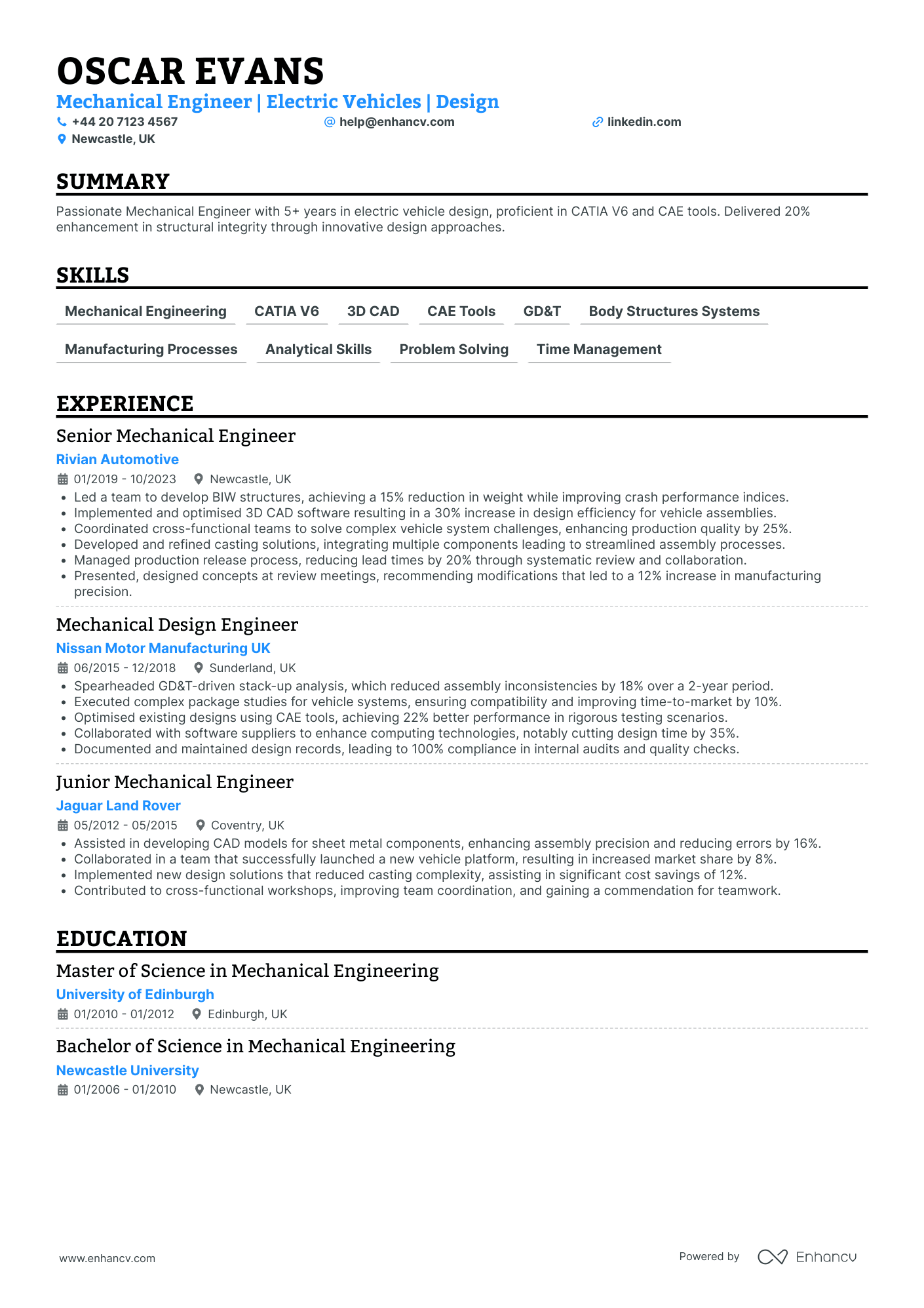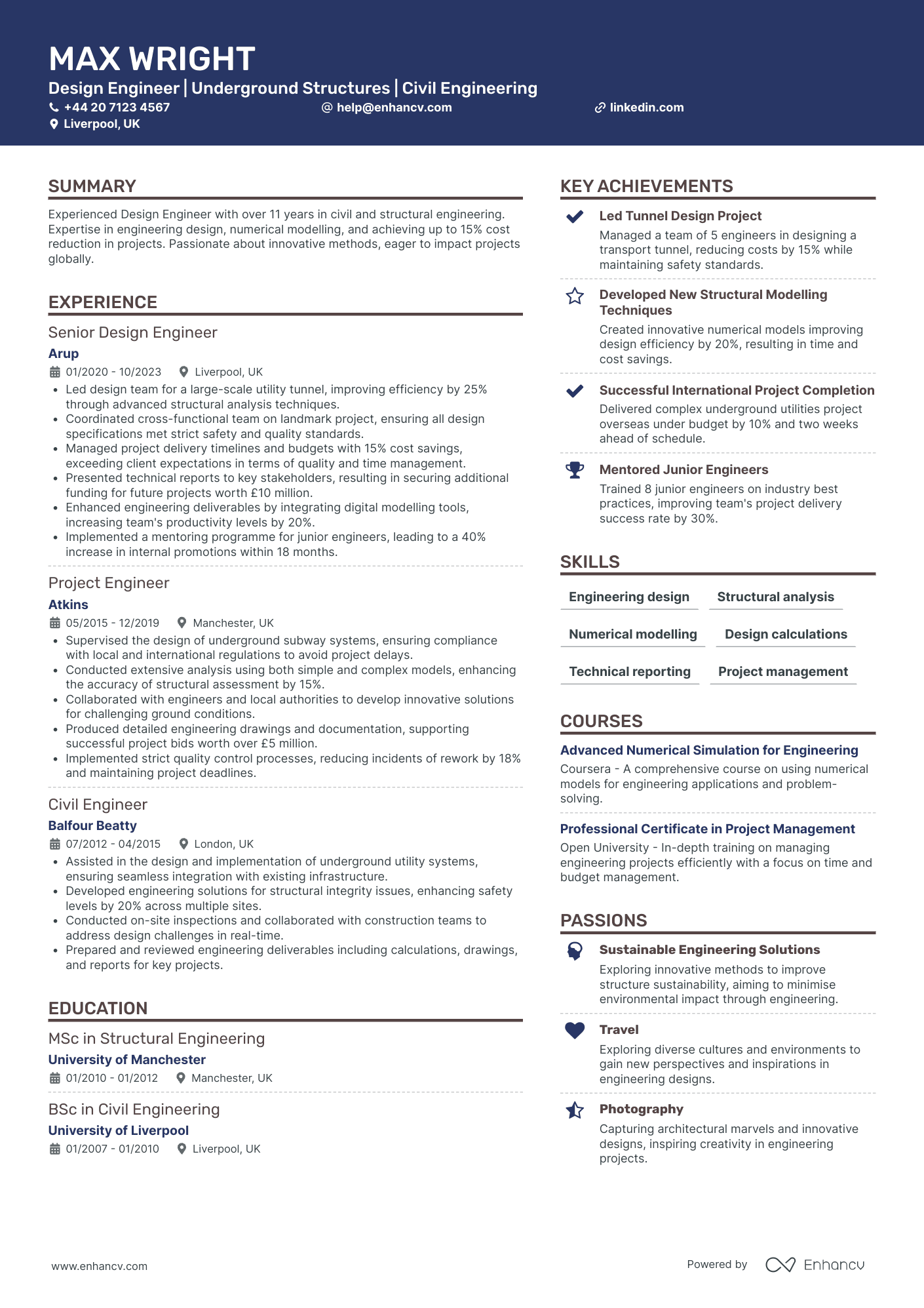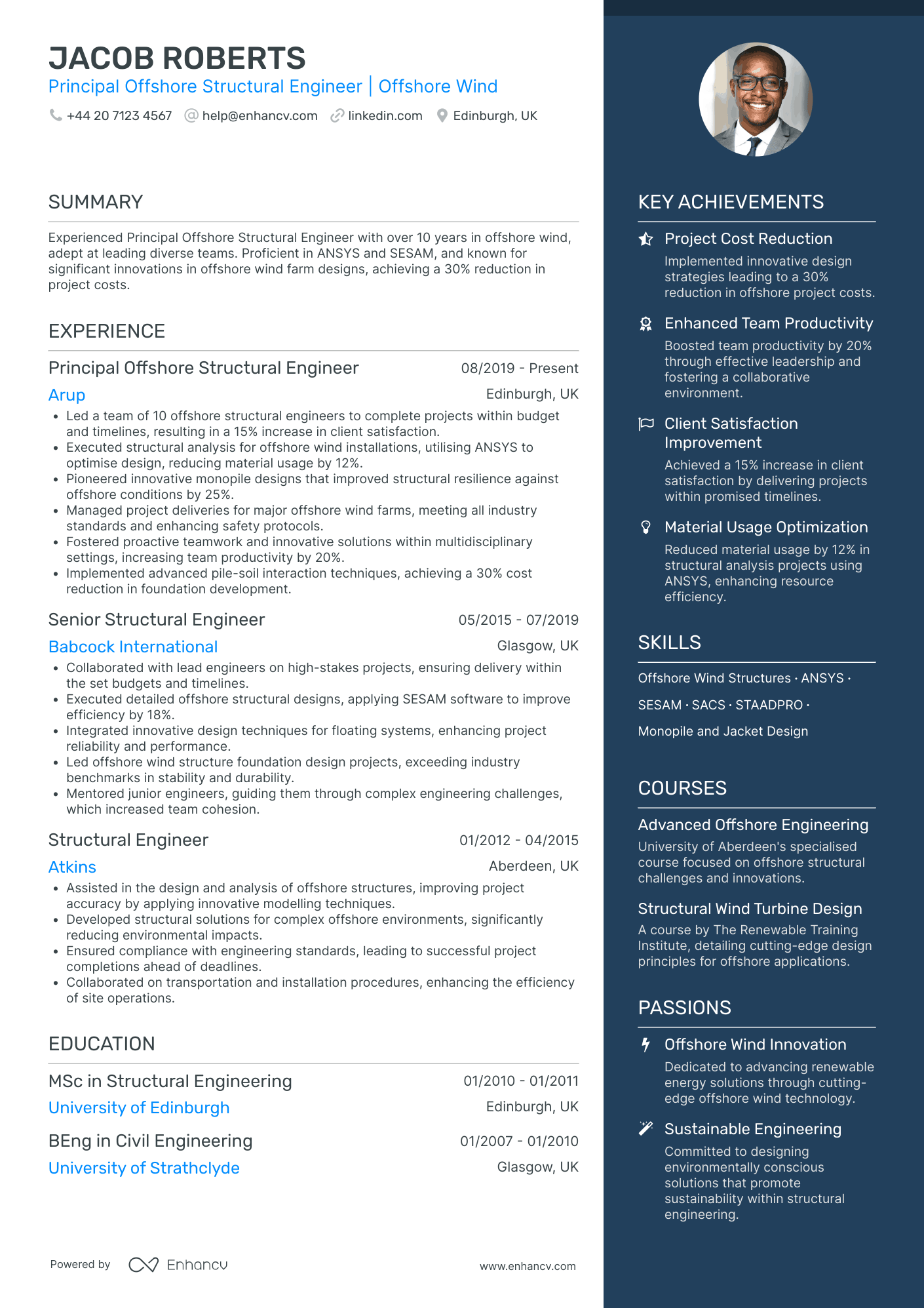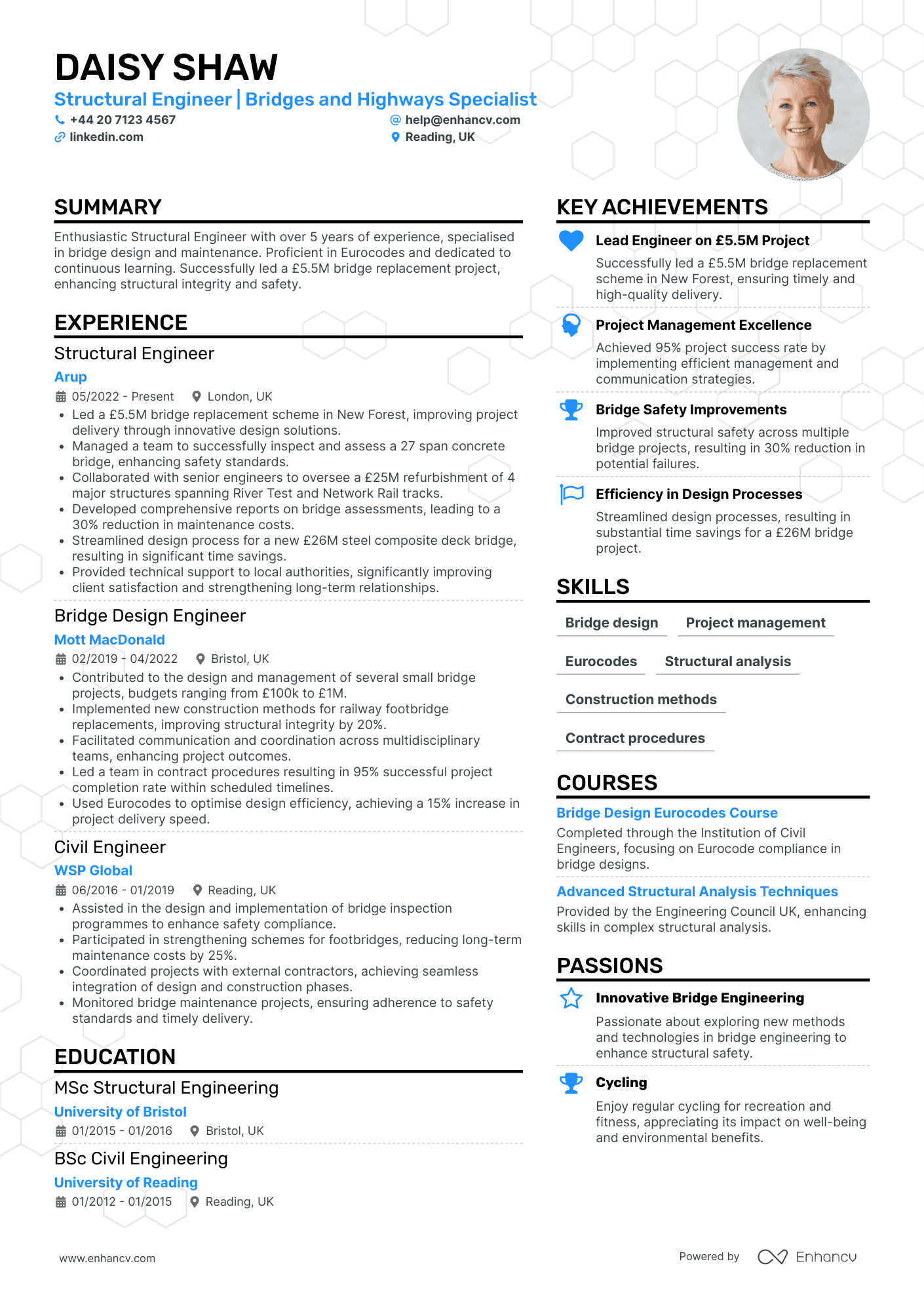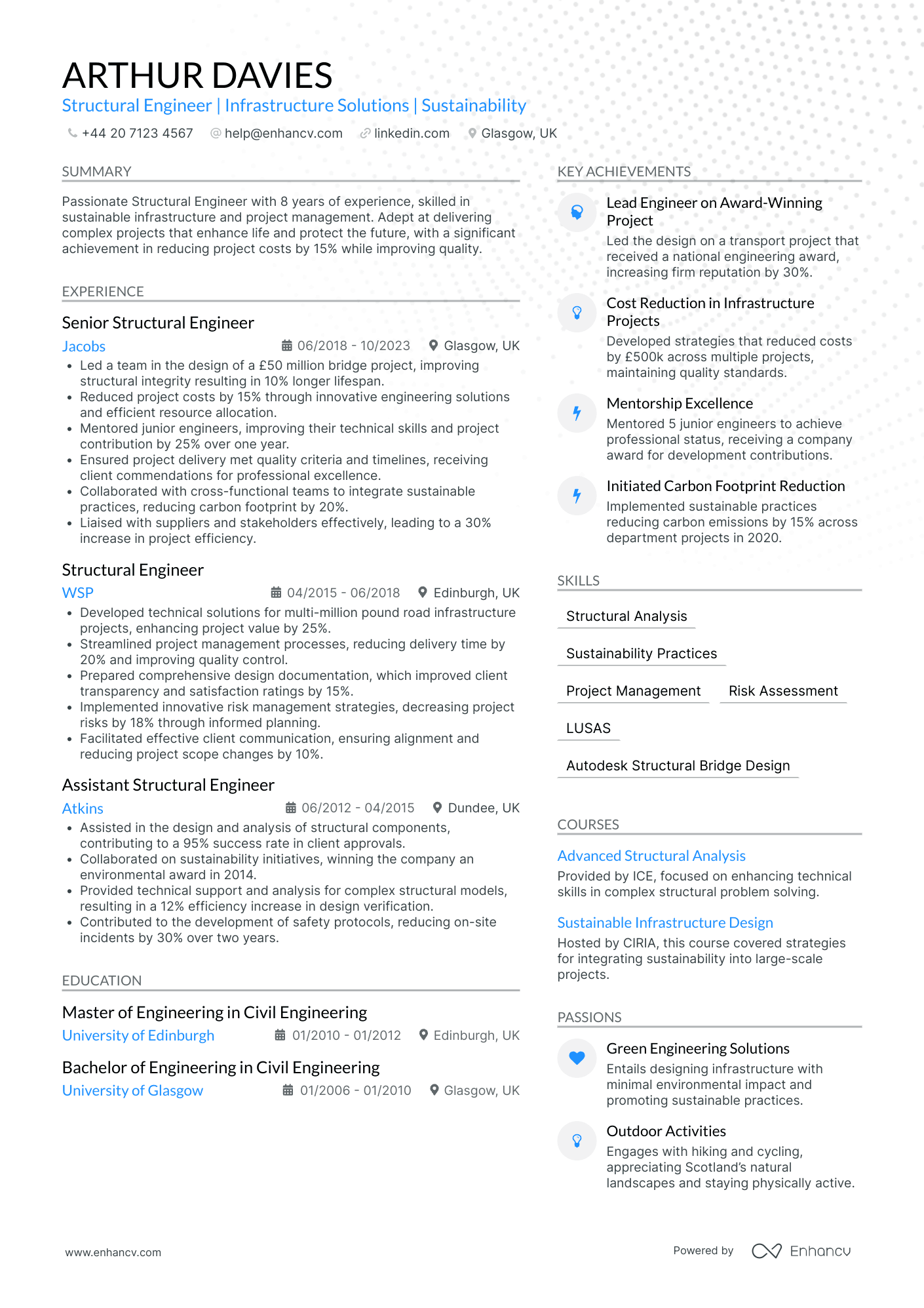Ensuring your curriculum vitae effectively showcases your proficiency in structural analysis and design can be a daunting task. Our guide will provide you with clear strategies to highlight your technical skills and project experience, making your application stand out to potential employers.
- Create an attention-grabbing header that integrates keywords and includes all vital information;
- Add strong action verbs and skills in your experience section, and get inspired by real-world professionals;
- List your education and relevant certification to fill in the gaps in your career history;
- Integrate both hard and soft skills all through your CV.
Discover more industry-specific guides to help you apply for any role in the links below:
CV examples for structural engineer
By Experience
Graduate Structural Engineer
- Effective Content Structuring and Clarity - This CV presents information through well-organized sections such as experience, education, skills, and achievements, ensuring clarity and ease of reading for any reviewer. It emphasizes important details like project size and impacts clearly, allowing potential employers to quickly gauge Eva’s contributions and expertise.
- Remarkable Career Progression - Eva Fisher’s career trajectory is notably marked by steady advances up the professional ladder, from a Structural Design Engineer to a Senior Structural Engineer. This progression showcases her adaptability and competence within her field, indicating a strong growth mindset and a deepening of her technical and leadership capabilities in the civil engineering industry.
- In-Depth Technical Expertise - The CV details Eva’s proficiency in handling complex engineering software and implementing advanced structural analysis techniques. Her innovative approaches to structural integrity checks and her role in optimizing project processes highlight her cutting-edge technical skills and industry-specific methodologies that underpin her engineering success.
Principal Structural Engineer
- Strategic Career Advancement - The candidate's career trajectory demonstrates significant growth from a Project Structural Engineer at Thales Group to the current position as Principal Structural Engineer at BAE Systems. This progression highlights a commitment to the field of marine engineering and illustrates a clear pathway of increasing responsibility and leadership within the industry.
- Depth of Industry-Specific Technical Expertise - Finley Robinson's CV is noteworthy for its detailed inclusion of industry-specific tools and methodologies like ANSYS and PD5500. This technical depth, combined with expertise in finite element modelling and hand calculations, establishes a solid foundation for handling complex structural challenges in marine environments.
- Impact-Driven Achievements - The achievements section effectively communicates tangible business impacts, such as a 30% increase in structural integrity, a 25% productivity boost, and a 20% reduction in failure rates. These metrics not only quantify success but also emphasize the candidate's strategic influence on project outcomes, showcasing their role in advancing organizational objectives.
Assistant Structural Engineer
- Structured and Concise Presentation - Poppy Griffiths's CV is organized in a logical and clear manner, effectively outlining sections such as experience, education, skills, and achievements. Each section is well-defined with bullet points that provide a concise overview of key responsibilities and accomplishments, ensuring readability and easy extraction of vital information.
- Diverse Career Progression - The career trajectory highlighted in the CV shows significant growth from a Junior Structural Engineer to an Assistant Structural Engineer. This advancement within distinguished firms like AECOM, Jacobs, and Arup indicates adaptability and the ability to thrive in diverse environments, enhancing the candidate’s industry credibility.
- Industry-Specific Expertise - The CV emphasizes Poppy's proficiency in critical technical tools such as AutoCAD, indicating a strong foundation in the civil engineering domain. Experience in structural assessments, condition assessment testing, and bridge asset management showcases a specialized skill set tailored to structural investigations, adding substantial technical depth to her profile.
Lead Structural Engineer
- Structured Career Growth - Jacob Roberts' career trajectory illustrates significant growth with clear upward progression. Starting as a Structural Engineer and advancing to Principal Offshore Structural Engineer within high-profile companies like Arup and Babcock International, the CV highlights consistent advancements in responsibilities, showcasing his career commitment and professional development in the offshore wind sector.
- Technical Expertise in Industry-Specific Tools - The CV underscores Roberts' proficiency with critical engineering software like ANSYS and SESAM, pivotal in offshore structural engineering. The demonstration of these competencies, along with specialized courses in advanced offshore engineering and wind turbine design, highlights his technical depth and readiness to tackle complex offshore challenges.
- Strategic Achievements with Tangible Impact - Notably, the achievements section provides not just numerical accomplishments but also contextualizes their business impact. For example, a 30% reduction in project costs through innovation and a 20% boost in team productivity emphasize Roberts' capability to drive efficiency and value, reinforcing his tangible contribution to project success and client satisfaction.
Junior Structural Engineer
- Structured and Concise Presentation - The CV is organized in a clear and logical structure, making it easy to absorb key information quickly. Each section is concise, highlighting relevant experiences and skills without overwhelming details, which enhances readability and focus.
- Consistent Career Growth - Arthur Davies's career trajectory reflects steady growth, moving from an intern position at Atkins to a graduate engineer role, and then to a structural engineer at Arup. This progression shows a solid build-up of expertise and responsibility in the field of structural engineering.
- Application of Advanced Tools and Techniques - The CV showcases the use of advanced industry tools like Tekla SD and Tedd's software, emphasizing Arthur’s technical proficiency and his commitment to achieving precision in structural assessments. It further underlines his capability to utilize complex methodologies for enhancing design accuracy.
By Role
Structural Engineer in Construction
- Demonstrates successful project management outcomes - The CV highlights Daisy Shaw's ability to achieve project success through efficient management strategies, as seen in her 95% project completion rate at Mott MacDonald. This indicates her skill in steering projects from conception to delivery successfully.
- Showcases industry specialization and continuous growth - Daisy’s career trajectory shows a clear focus on bridge and highway projects, with a progression from Civil Engineer to Structural Engineer. Her continuous involvement in significant, large-scale projects showcases a deepening expertise and dedication to her specialty.
- Emphasizes technical proficiency with relevant methodologies - The CV effectively highlights Daisy's familiarity with essential structural engineering tools and standards, such as Eurocodes, AutoCAD, and Finite Element Analysis. Her advanced skills are underscored by relevant coursework and achievements in implementing innovative design solutions.
Structural Design Engineer
- Well-structured and Transparent Layout - The CV employs a clear, concise structure that allows for easy comprehension of Isaac Scott’s career and skills. Each section is distinctly labeled, facilitating a quick grasp of his qualifications, experience, and achievements, which are all directly relevant to a Structural Design Engineer's role.
- Continuous Career Advancement - Isaac Scott’s career trajectory demonstrates steady progression with increased responsibility over time. His roles from Transmission Design Engineer to Structural Design Engineer reflect significant growth, taking on more complex projects and leadership in engineering teams, highlighting his dedication and capability in the field.
- Industry-Specific Technical Mastery - Highlighting unique industry-specific elements like proficiency in PLS Tower Design Software and expertise in overhead steel lattice structures presents Isaac as not only knowledgeable but also technically adept. His advanced training and courses further display his technical depth within the engineering domain.
Structural Engineer in Aerospace
- Well-Structured and Concisely Detailed - The CV stands out due to its clear and logical structure, making it easy to navigate through sections like Experience, Education, and Skills. Each bullet point provides specific details about job responsibilities and achievements, ensuring concise yet comprehensive insight into the candidate's expertise.
- Steady Career Advancement in Aerospace Engineering - The candidate's career trajectory showcases a consistent climb within the aerospace sector, moving from an FEA Engineer at Airbus to a Senior Structural Engineer at BAE Systems. This progression highlights their growing expertise and leadership capabilities in the field of structural engineering and finite element analysis.
- Utilization of Specialized Tools and Techniques - This CV emphasizes the candidate's proficiency with industry-specific tools such as Simcenter 3D and Nastran, essential for complex FEA tasks. The inclusion of methodologies like design optimization and fatigue analysis underlines their technical depth and specialized skill set relevant to aerospace engineering.
Structural Engineer in Marine Engineering
- Comprehensive career progression - The CV demonstrates a clear and progressive career trajectory, highlighting Harper Webb's growth from a Structural Engineer to a Principal Structural Engineer. This upward movement signifies a successful career, marked by increasingly responsible roles and leadership positions within renowned companies in the industry.
- Emphasis on technical expertise and advanced methodologies - With a strong focus on advanced technical skills, the CV showcases proficiency in specific tools and methodologies like CAD, FEA, ABAQUS, and Eurocodes. This technical depth underlines Harper’s capability to handle complex structural engineering challenges, particularly in specialized environments like marine engineering.
- Effective leadership and cross-functional collaboration - The document highlights Harper's ability to lead and manage teams across various functions, ensuring compliance and optimizing processes. The CV mentions specific achievements in leading cross-functional teams to evaluate structural integrity and improving productivity, illustrating a well-rounded skill set that extends beyond purely technical responsibilities.
Structural Analysis Engineer
- Strategic Career Growth - Freya Richardson's career trajectory exhibits a steady progression from a Junior Structural Engineer to a Senior role over a decade. This growth not only highlights her expertise and dedication within the structural engineering sector but also her ability to tackle increasing responsibilities at renowned companies like Rolls-Royce and BAE Systems.
- Robust Technical Proficiency - The CV is infused with industry-specific elements such as finite element analysis (FEA) and stress calculations, demonstrating Freya's deep technical understanding and application of innovative methodologies that benefit her projects. Her fluency in advanced engineering software and techniques is evident, notably in her leading roles that reduced calculation times and enhanced project outcomes.
- Impactful Achievements - Freya's achievements, such as the Efficiency Improvement Award and Innovative Design Champion, underscore her ability to drive measurable improvements in project efficiency and material cost savings. These recognitions not only validate her technical prowess but also her innovative approach to enhancing structural safety and efficiency, making her contributions highly relevant within the engineering community.
Structural Engineer in Energy
- Clear and Structured Presentation - The CV is presented in a concise and organized manner, which helps to quickly communicate Ruby Gibson's qualifications and experience. Each section is distinctly highlighted, from the summary to detailed job responsibilities and achievements, ensuring that essential information is easily accessible and understandable.
- Progressive Career Growth - Ruby's career trajectory reflects a dynamic progression within the field of structural engineering, advancing from a Junior Structural Engineer to a Principal position. The promotions within renowned companies like Babcock International, Atkins, and Jacobs Engineering Group illustrate consistent performance and recognition in the industry.
- Implementation of Innovative Tools - The CV emphasizes Ruby's proficiency with industry-specific software like Robot Structural Analysis and Tekla Structural Designer, showcasing her technical depth. This focus on cutting-edge tools highlights her capability to improve design accuracy and efficiency, which is critical in structural engineering projects.
Structural Engineer in Civil Infrastructure
- Impressive Career Growth and Leadership - The CV demonstrates a clear upward trajectory in Arthur Davies' career, from Assistant Structural Engineer to Senior Structural Engineer, reflecting considerable professional development and recognition in the industry. His role in leading a £50 million bridge project and mentoring junior engineers highlights his capacity for leadership and the trust placed in him by employers.
- Diverse Skill Set and Technical Expertise - Arthur showcases a well-rounded skill set tailored to the structural engineering field. His proficiency with tools like LUSAS and Autodesk Structural Bridge Design, coupled with knowledge of CDM Regulations and Eurocodes, illustrate his technical depth and industry-specific competence. This technical fluency supports his ability to deliver complex, high-quality infrastructure solutions.
- Significant Achievements with Business Impact - The document details Arthur's contributions to cost reduction and sustainability in engineering projects. Notably, he reduced project costs by £500k and decreased carbon footprint by 20%. These achievements underscore his effectiveness in incorporating sustainable practices and innovative engineering solutions to drive significant business benefits.
Structural Engineer in Oil and Gas
- Clear and Structured Presentation - The CV is presented in a well-organized manner, featuring distinct sections for experience, education, skills, and achievements. This structured approach ensures that the most relevant information is easily accessible and allows for a concise and impactful delivery of the candidate’s professional background and qualifications.
- Demonstrates Career Growth - Charlie Thomas’s CV reflects a clear career progression, moving from a project coordinator role to design and then structural engineering positions. This trajectory highlights his growing expertise and responsibilities in the offshore engineering domain, underscoring his capability to handle complex tasks and projects effectively.
- Technical Depth and Industry-Specific Expertise - The CV emphasizes strengths in offshore engineering with specialized skills, such as dynamic structural analysis and subsea design. The candidate's experience in reducing failure rates and material costs, coupled with knowledge in hydrodynamic calculations and integrity management, demonstrates a high level of technical proficiency necessary for impactful contributions to engineering projects.
Structural Engineer in Manufacturing
- Projection of consistent leadership and growth - The CV illustrates a clear career trajectory through strategic promotions, starting from a Structural Engineer role at Atkins to becoming a Principal Structural Engineer at Arup. This progression demonstrates Theodore Green's capacity for assuming increased responsibilities and spearheading major projects, evidencing a strong leadership pathway within the industry.
- Emphasis on interdisciplinary collaboration and mentoring - It effectively highlights Theodore's adaptability and ability to operate in cross-functional teams. The CV underscores Theodore's contributions towards mentorship and fostering team productivity, showcasing his commitment to developing young engineers and promoting a collaborative working environment, which is crucial in complex project settings.
- Detail-oriented achievements enhancing business outcomes - Beyond presenting individual accomplishments, the CV conveys the strategic business impact of Theodore's work—illustrating how specific actions led to securing £3 million in contracts, reducing project costs by 15%, and cutting design errors by 20%. These metrics contextualize his contributions within broader business objectives, underscoring his ability to align engineering solutions with company goals.
Structural Engineer in Telecommunications
- Content presentation enhances quick comprehension - The CV is well-structured, using clear sections to present Harry Williams' qualifications, experience, and skills concisely. This logical organization allows for quick assessment of their expertise in structural engineering, telecom infrastructure design, and CAD specialization.
- Career trajectory showcases consistent growth - Harry Williams’ career path reflects a progression from Structural Design Engineer to Lead Structural Engineer, highlighting their capability to take on more responsibilities and leadership roles over time. This growth signals their adaptability and the trust employers place in their skills and expertise.
- Emphasis on impactful achievements - The CV details achievements with significant business impact, such as enhancing project delivery timelines by 20% and saving £30,000 in costs. These metrics provide concrete evidence of Harry's ability to contribute to an organization's success, underlining their effectiveness and strategic thinking in project management.
Structural Engineer in Transportation
- Structured and Concise Presentation - The CV effectively organizes information using distinct sections, presenting Elsie Murray’s qualifications and experiences clearly. Each section is concise yet comprehensive, ensuring ease of navigation and understanding for potential employers.
- Progressive Career Trajectory - Elsie’s career path is marked by a clear progression from a Graduate Structural Engineer to a Senior Structural Engineer, illustrating a commitment to professional growth and the attainment of advanced roles through demonstrated expertise and leadership potential.
- Technical Expertise and Industry Tools - The CV showcases proficiency with industry-standard tools and methodologies like SAP2000, Midas Civil, and advanced Finite Element Analysis, underscoring Elsie's technical depth and ability to handle complex structural engineering projects effectively.
Structural Engineer in Environmental Engineering
- Clear and Structured Presentation - Eva Fisher's CV stands out with its organized and concise layout, making it easy to navigate through her career progression and skills. Key sections like Experience, Education, and Skills are clearly defined, allowing a reader to quickly understand her qualifications and career journey.
- Strong Career Growth in Engineering - The CV reflects a steady upward trajectory from a Structural Engineer to a Structural Design Engineer, highlighting her increased responsibilities and leadership roles at major engineering firms such as AECOM and Mott MacDonald. Each role demonstrates a consistent evolution in expertise and impact.
- Technical Expertise and Innovative Approaches - Eva utilizes industry-specific tools like AutoCAD, Revit, and RISA 3D, which showcase her technical proficiency. Her ability to streamline and improve project processes underscores a deep understanding of structural engineering complexities, vital for her role.
Structural Engineer in Architecture
- Clear and Strategic Content Presentation - Oscar Evans' CV is laid out in a structured and concise manner, efficiently guiding the reader through his professional journey. The use of bullet points for responsibilities and achievements ensures clear readability and highlights key accomplishments in a digestible format, making it easy to understand his career impact at a glance.
- Consistent Career Growth and Industry Specialization - The CV details a steady career progression from Junior Mechanical Engineer to Senior Mechanical Engineer in well-regarded automotive companies, reflecting committed growth and increasing responsibility. The focus on electric vehicles suggests specialization within a rapidly evolving industry, aligning with current market trends.
- Impactful Achievements with Business Relevance - Oscar's achievements are not only quantified but also contextualized in terms of their business relevance, such as streamlining processes to boost manufacturing efficiency by 30% and innovative designs leading to a 20% enhancement in structural integrity. These accomplishments demonstrate his ability to positively affect the bottom line and operational efficiency.
Structural Engineer in Mining
- Illustrates Career Progression and Consistency - Max Wright's CV clearly demonstrates a steady progression from Civil Engineer to Senior Design Engineer within reputable firms. The upward trajectory highlights a consistent career in underground structures, emphasizing his ability to grow within the field while taking on increased responsibilities and leadership roles.
- Showcases Technical Depth and Innovation - The CV is rich with industry-specific elements, such as advanced numerical modelling and digital modelling tools, which underscore Max's technical expertise and innovative approach. His involvement in developing new structural modelling techniques and enhancing engineering deliverables with digital tools highlights his cutting-edge skills in civil engineering.
- Effective Presentation of Measurable Achievements - The inclusion of precise achievements, such as reducing project costs by 15% and enhancing team project delivery success rate by 30%, provides tangible evidence of his impact. These achievements not only show numerical success but also convey his ability to lead cost-efficient projects while maintaining quality and safety standards.
Structuring and formatting your structural engineer CV for an excellent first impression
The experts' best advice regarding your CV format is to keep it simple and concise. Recruiters assessing your CV are foremost looking out for candidates who match their ideal job profile. Your white space, borders, and margins. You may still be wondering which format you need to export your CV in. We recommend using the PDF one, as, upon being uploaded, it never alters your information or CV design. Before we move on to the actual content of your structural engineer CV, we'd like to remind you about the Applicant Tracker System (or the ATS). The ATS is a software that is sometimes used to initially assess your profile. Here's what you need to keep in mind about the ATS:
- All serif and sans-serif fonts (e.g. Rubik, Volkhov, Exo 2 etc.) are ATS-friendly;
- Many candidates invest in Arial and Times New Roman, so avoid these fonts if you want your application to stand out;
- Both single and double column CVs can be read by the ATS, so it's entirely up to you to select your CV design.
PRO TIP
For certain fields, consider including infographics or visual elements to represent skills or achievements, but ensure they are simple, professional, and enhance rather than clutter the information.
The top sections on a structural engineer CV
- Personal Profile details your expertise and goals, enticing recruiters.
- Work Experience showcases relevant projects and responsibilities.
- Education and Qualifications highlight structural engineering credentials.
- Key Skills reflect essential engineering competencies and software proficiencies.
- Professional Memberships display commitment to the field and ongoing learning.
What recruiters value on your CV:
- Highlight relevant engineering qualifications and continuous professional development, including your degree in civil or structural engineering, and any additional certifications such as Chartered Engineer (CEng) status.
- Emphasise your proficiency with industry-standard design software like AutoCAD, Revit, STAAD.Pro, and ANSYS, showcasing projects where you've successfully applied these tools.
- Detail your experience with various structural materials and construction methods, focusing on your understanding of their applications and limitations within different engineering projects.
- Include specific examples of projects you've worked on, such as bridges, buildings, or tunnels, and mention your role in the design, analysis, and management of these structures.
- Discuss your ability to comply with building codes and regulations, highlighting any experience you have in liaising with local authorities and stakeholders to gain project approvals.
Recommended reads:
How to present your contact details and job keywords in your structural engineer CV header
Located at the top of your structural engineer CV, the header presents recruiters with your key personal information, headline, and professional photo. When creating your CV header, include your:
- Contact details - avoid listing your work email or telephone number and, also, email addresses that sound unprofessional (e.g. koolKittyCat$3@gmail.com is definitely a big no);
- Headline - it should be relevant, concise, and specific to the role you're applying for, integrating keywords and action verbs;
- Photo - instead of including a photograph from your family reunion, select one that shows you in a more professional light. It's also good to note that in some countries (e.g. the UK and US), it's best to avoid photos on your CV as they may serve as bias.
What do other industry professionals include in their CV header? Make sure to check out the next bit of your guide to see real-life examples:
Examples of good CV headlines for structural engineer:
- Chartered Structural Engineer | MEng Civil Engineering | High-Rise Structures Expert | 10 Years' Experience
- Senior Structural Analyst | Project Management Pro | Earthquake Resistant Design Specialist | 15+ Years in Industry
- Graduate Structural Designer | Proficient in BIM and CAD | Scaffold Design Enthusiast | IStructE Cert.
- Principal Structural Consultant | PhD in Structural Dynamics | Infrastructure Renewal Strategist | 20+ Years' Expertise
- Mid-Level Structural Engineer | MSc Structural Engineering | Steelwork Design Aficionado | 5 Years’ Professional Practice
- Lead Structural Engineer | Chartered Member of IStructE | Expert in Retrofitting Heritage Buildings | 12 Years Experience
Your structural engineer CV introduction: selecting between a summary and an objective
structural engineer candidates often wonder how to start writing their resumes. More specifically, how exactly can they use their opening statements to build a connection with recruiters, showcase their relevant skills, and spotlight job alignment. A tricky situation, we know. When crafting you structural engineer CV select between:
- A summary - to show an overview of your career so far, including your most significant achievements.
- An objective - to show a conscise overview of your career dreams and aspirations.
Find out more examples and ultimately, decide which type of opening statement will fit your profile in the next section of our guide:
CV summaries for a structural engineer job:
- Dedicated Structural Engineer with over 12 years of experience in designing resilient infrastructures, including high-rise buildings and bridges. Proficient in using advanced finite element software, and has significantly improved load-bearing efficiency by 18% in previous projects through innovative engineering solutions.
- Resourceful Civil Engineer transitioning into Structural Engineering, bringing 5 years of experience in sustainable urban development. Equipped with a deep understanding of material science and adept at structural optimization, aiming to contribute to complex architectural projects requiring advanced technical knowledge.
- Accomplished Mechanical Engineer refocusing career towards structural engineering, leveraging a strong background in dynamics and materials strength analysis. With over 8 years of experience, aims to address modern engineering challenges in civil constructions by implementing robust design principles attained from the automotive industry.
- Dynamic graduate with a MEng in Structural Engineering from University College London, aspiring to apply theoretical knowledge and fresh perspective to practical challenges. Adept in 3D-modelling software and eager to contribute to impactful infrastructure projects, underscoring a commitment to sustainable and innovative design practices.
- Seeking to embark on a career in Structural Engineering, enthusiastic to develop specialised skills in seismic-resistant techniques and to utilise a solid foundation in physics and mathematics. Committed to lifelong learning and eager to grow within a firm that values cutting-edge solutions to design and building challenges.
How to meet job requirements with your structural engineer CV experience
We've now reached the essence of your actual CV - your experience section. This is the space where you can list your career roles and on-the-job successes. Many candidates tend to underestimate just how much time and effort they should put into writing this CV section. Your experience shouldn't be a random list of your responsibilities, but instead:
- Match the job description with your skills, values, and accomplishments;
- Start each bullet with a strong action verb, followed up with one key skill and your outcome of applying this skill;
- Spotlight parts of your career history that are relevant to the job you're applying for.
Before we move on, make sure to check out some professional CV experience sections.
Best practices for your CV's work experience section
- Analysed structural components for commercial and residential buildings, employing advanced software tools to ensure compliance with relevant codes and safety standards.
- Coordinated with architects and construction teams to integrate structural systems into overall building designs, delivering project solutions within established timelines and budgets.
- Conducted on-site inspections and structural assessments of existing structures for renovation projects, identifying critical areas for reinforcement and providing detailed reports.
- Prepared technical documentation, including structural calculations, drawings, and specifications, ensuring all materials and designs adhered to legislative and industry best practices.
- Led a team of junior engineers and technicians, providing mentorship and overseeing their work to maintain high quality and accuracy in structural analysis and design.
- Utilised Building Information Modelling (BIM) techniques to create detailed 3D models, facilitating better communication and coordination among various disciplines.
- Implemented sustainable design principles in structural engineering projects, optimizing material usage to reduce environmental impact and enhance energy efficiency.
- Stayed abreast of technological advancements in the field of structural engineering, integrating innovative materials and methods to improve design outcomes and operational efficiency.
- Presented findings and progress updates to clients and stakeholders during project meetings, effectively communicating technical information to non-engineering audiences.
- Led the structural analysis and design of a 30-story mixed-use high-rise incorporating sustainable building practices, delivering the project 10% under budget.
- Managed a team of 6 junior engineers and 2 technicians, fostering skill development and leading to the successful deployment of an advanced finite element analysis software across the department.
- Authored and presented a white paper on earthquake-resistant design methodologies at an international engineering conference attended by 500+ industry professionals.
- Oversaw the construction phase of a £20M pedestrian bridge, ensuring structural specifications were upheld and quality standards met, resulting in zero safety incidents throughout the duration of the project.
- Conducted advanced dynamic analyses for structural vibration issues on large-scale machinery foundations, enhancing operational efficiencies by 15%.
- Spearheaded the implementation of Building Information Modelling (BIM) processes, reducing project delivery times by an average of 25% across the company.
- Played a key role in the structural renovation of historic Grade I listed buildings, ensuring compliance with stringent heritage conservation regulations.
- Collaborated with architects to integrate innovative structural solutions that increased floor space by 20% without compromising building integrity.
- Developed and executed a comprehensive risk assessment protocol that decreased project delays by 30%, directly impacting profitability.
- Currently leading the seismic retrofitting project for a government complex, enhancing the structure's resistance to earthquakes by 50%, safeguarding hundreds of employees.
- Directing a cross-functional team to deploy modular construction techniques in a series of residential buildings, accelerating project timelines by 40% whilst maintaining high-quality standards.
- Pioneered the adoption of ultra-high-performance concrete in the construction of a major bridge, reducing maintenance costs by an estimated £1M over the lifespan of the structure.
- Designed and supervised the installation of an innovative glass curtain wall system for a high-profile commercial skyscraper, achieving a LEED Silver certification for sustainability.
- Expertly addressed unique geotechnical challenges during the groundwork phase of a large urban development, minimising the risk of subsidence and maximising land use.
- Implemented cost-saving measures that reduced the overall material expenditure by 12%, without compromising on the structural integrity and design aesthetics.
- Developed bespoke structural solutions for complex geometric façades in collaboration with renowned architects, contributing to the firm's reputation for innovative design.
- Utilised 3D structural simulation to optimise design proposals, ensuring efficient material usage and meeting all regulatory requirements.
- Mentored a multi-disciplinary graduate program, leading to improved project delivery and the cultivation of a talent pool highly proficient in the latest structural design software.
- Utilised progressive collapse analysis to ensure a robust design for a government embassy, meeting top-tier security standards and accommodating anti-terrorism considerations.
- Orchestrated a research project into the use of carbon-fiber composites in reinforced concrete, yielding a 25% increase in tensile strength for tested elements.
- Actively engaged with key stakeholders throughout project lifecycles, resulting in consistently met deadlines and increased client satisfaction by 18%.
- Directed the development of an experimental lightweight floor system that provides a 20% reduction in material weight while sustaining high-load capacities.
- Successfully navigated the complexities of cross-laminated timber (CLT) construction for residential buildings, setting a precedent for sustainable practices in the industry.
- Played a pivotal role in creating a detailed structural health monitoring plan for critical infrastructures, enhancing longevity and reducing unforeseen repair costs.
How to ensure your structural engineer CV stands out when you have no experience
This part of our step-by-step guide will help you substitute your experience section by helping you spotlight your skill set. First off, your ability to land your first job will depend on the time you take to assess precisely how you match the job requirements. Whether that's via your relevant education and courses, skill set, or any potential extracurricular activities. Next:
- Systematise your CV so that it spotlights your most relevant experience (whether that's your education or volunteer work) towards the top;
- Focus recruiters' attention to your transferrable skill set and in particular how your personality would be the perfect fit for the role;
- Consider how your current background has helped you build your technological understanding - whether you've created projects in your free time or as part of your uni degree;
- Ensure you've expanded on your teamwork capabilities with any relevant internships, part-time roles, or projects you've participated in the past.
Recommended reads:
PRO TIP
If you have experience in diverse fields, highlight how this has broadened your perspective and skill set, making you a more versatile candidate.
Hard skills and soft skills to showcase your unique skill set on your structural engineer CV
Did you know that your CV will mostly likely be assessed by recruiters based on skill alignment? And that means that the way you feature your key skills across different CV sections will play a crucial role in landing you that first interview. We recommend you add your:
- technical capabilities or hard skills in your CV experience, certificates, projects, etc. Use your past accomplishments to prove your technical capabilities. List up to a dozen different software or hardware in your dedicated skills section to match the job keywords;
- personal and communication skills or soft skills in your CV strengths, achievements, summary/ objective, etc. Soft skills are a bit more difficult to prove. How do you define your aptitude in active listening? So, instead of just listing the skill name, include a tangible metric to show your success.
On a final note, when you're in a hurry to create your profile, you may misspell a particular technology or soft skill. That's why we suggest you copy and paste the particular skill name (or keyword), directly from the job advert. This would also help you to pass any initial Applicant Tracker System (ATS) tests.
Top skills for your structural engineer CV:
Structural analysis
Structural design
Knowledge of building codes and standards
Proficiency with structural analysis software (e.g., SAP2000, ETABS, STAAD.Pro)
Reinforced concrete design
Steel structure design
Finite element analysis
Seismic design and analysis
Foundation design
Understanding of construction methods
Problem-solving
Critical thinking
Attention to detail
Communication skills
Time management
Project management
Teamwork and collaboration
Adaptability
Leadership abilities
Continuous learning
PRO TIP
Focus on describing skills in the context of the outcomes they’ve helped you achieve, linking them directly to tangible results or successes in your career.
CV education and certificates: your academic background as proof of your skill set
A common misconception about your structural engineer CV education is that you only need it, if you have less professional experience. That is completely false. The CV education section serves to back up your technical (and sometimes personal) capabilities, fill in gaps in your work history, and show you have the initial industry background and know-how. When creating your education section:
- List your degrees in the reverse chronological order, starting with the most recent (and relevant) ones first;
- Include your degree and university names, start and graduation dates. It's optional to also denote you received a "First-Class Honours" for diplomas that are more relevant to the role;
- Curate your relevant university coursework, projects, or thesis work if you happen to have less professional expertise and need to integrate more job keywords and skills.
Your professional qualifications don't need to stop at your academic background. It's advisable to also select up to three of your most noteworthy (and relevant) industry certificates and feature them in a dedicated section. Once more, include the certificate name, the institution that issued it out, and the date you obtained it on. You could feature both hard skills and soft skills certificates, as in the examples below:
PRO TIP
If you have received professional endorsements or recommendations for certain skills, especially on platforms like LinkedIn, mention these to add credibility.
Recommended reads:
Key takeaways
Here are five things you need to remember about writing your structural engineer CV for success:
- Sort your experience based on the reverse chronological order, starting with your most recent career items, to showcase how you've grown your career;
- Include within your CV header your relevant contact details, a headline that could spotlight your unique value, and a photo - if you're applying for roles outside the UK or US;
- Decide to use the CV summary, if you happen to have more professional experience, and an objective, if you want to showcase your career goals;
- Within the experience section, write your bullets using action verbs, skills, and success, instead of just merely listing your on-the-job responsibilities;
- Prove your technical skills, using your education and certificates, and your soft skills, with your achievements and strengths sections.
